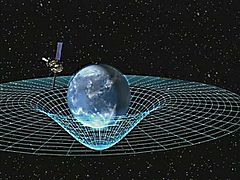
Back متجه رباعي Arabic 4-вектор Bulgarian চার-ভেক্টর Bengali/Bangla Quadrivector Catalan Čtyřvektor Czech 4-вектор CV 4-vektor Danish Vierervektor German Cuadrivector Spanish چهاربردار Persian
| Part of a series on |
| Spacetime |
|---|
 |
In special relativity, a four-vector (or 4-vector, sometimes Lorentz vector)[1] is an object with four components, which transform in a specific way under Lorentz transformations. Specifically, a four-vector is an element of a four-dimensional vector space considered as a representation space of the standard representation of the Lorentz group, the (1/2,1/2) representation. It differs from a Euclidean vector in how its magnitude is determined. The transformations that preserve this magnitude are the Lorentz transformations, which include spatial rotations and boosts (a change by a constant velocity to another inertial reference frame).[2]: ch1
Four-vectors describe, for instance, position xμ in spacetime modeled as Minkowski space, a particle's four-momentum pμ, the amplitude of the electromagnetic four-potential Aμ(x) at a point x in spacetime, and the elements of the subspace spanned by the gamma matrices inside the Dirac algebra.
The Lorentz group may be represented by 4×4 matrices Λ. The action of a Lorentz transformation on a general contravariant four-vector X (like the examples above), regarded as a column vector with Cartesian coordinates with respect to an inertial frame in the entries, is given by
(matrix multiplication) where the components of the primed object refer to the new frame. Related to the examples above that are given as contravariant vectors, there are also the corresponding covariant vectors xμ, pμ and Aμ(x). These transform according to the rule
where T denotes the matrix transpose. This rule is different from the above rule. It corresponds to the dual representation of the standard representation. However, for the Lorentz group the dual of any representation is equivalent to the original representation. Thus the objects with covariant indices are four-vectors as well.
For an example of a well-behaved four-component object in special relativity that is not a four-vector, see bispinor. It is similarly defined, the difference being that the transformation rule under Lorentz transformations is given by a representation other than the standard representation. In this case, the rule reads X′ = Π(Λ)X, where Π(Λ) is a 4×4 matrix other than Λ. Similar remarks apply to objects with fewer or more components that are well-behaved under Lorentz transformations. These include scalars, spinors, tensors and spinor-tensors.
The article considers four-vectors in the context of special relativity. Although the concept of four-vectors also extends to general relativity, some of the results stated in this article require modification in general relativity.
- ^ Rindler, W. Introduction to Special Relativity (2nd edn.) (1991) Clarendon Press Oxford ISBN 0-19-853952-5
- ^ Sibel Baskal; Young S Kim; Marilyn E Noz (1 November 2015). Physics of the Lorentz Group. Morgan & Claypool Publishers. ISBN 978-1-68174-062-1.

